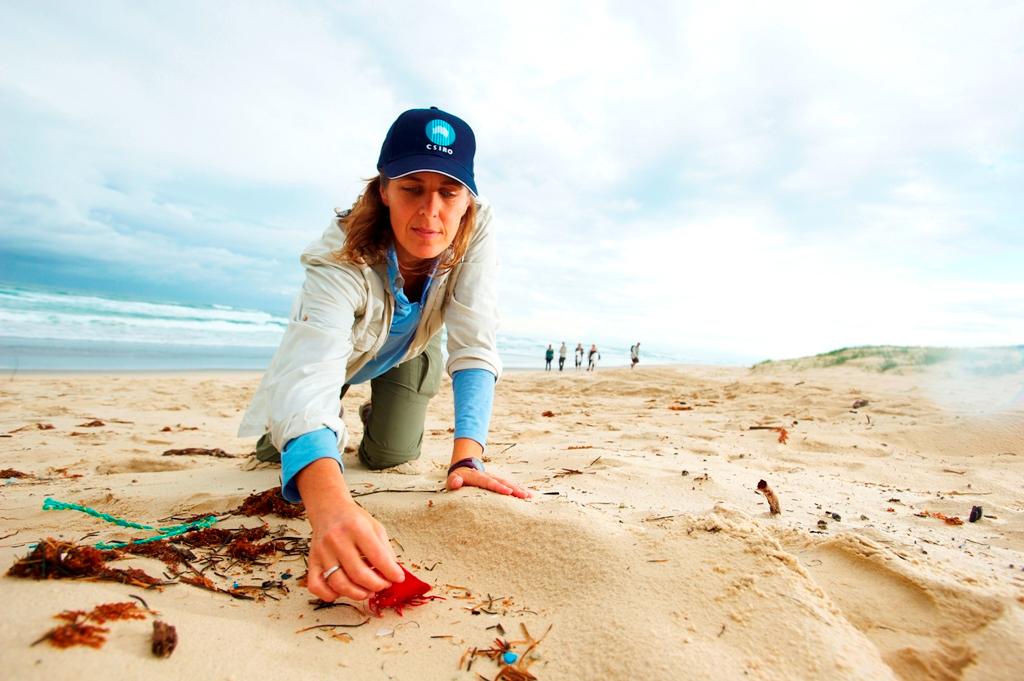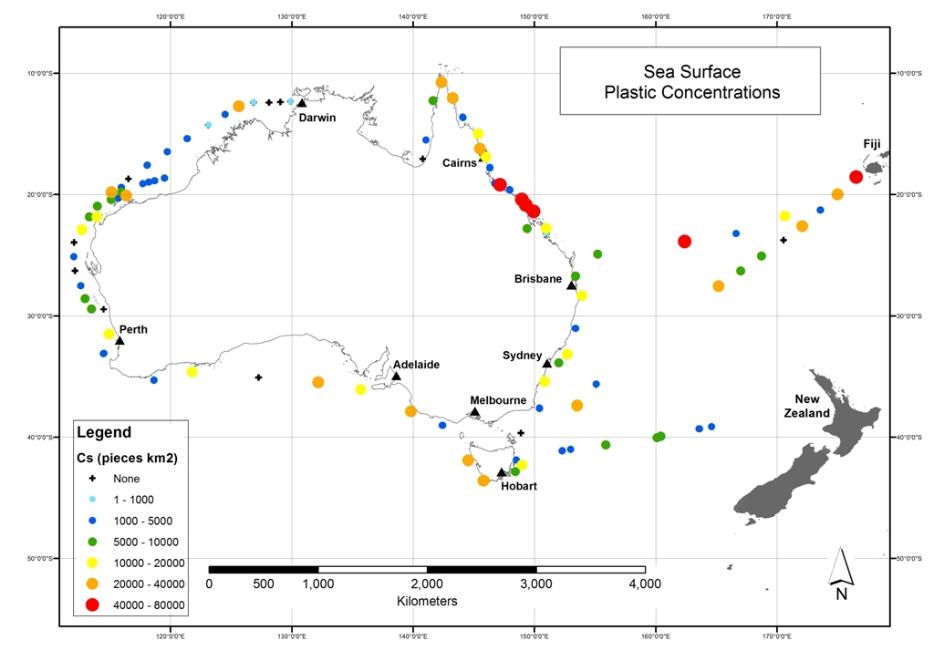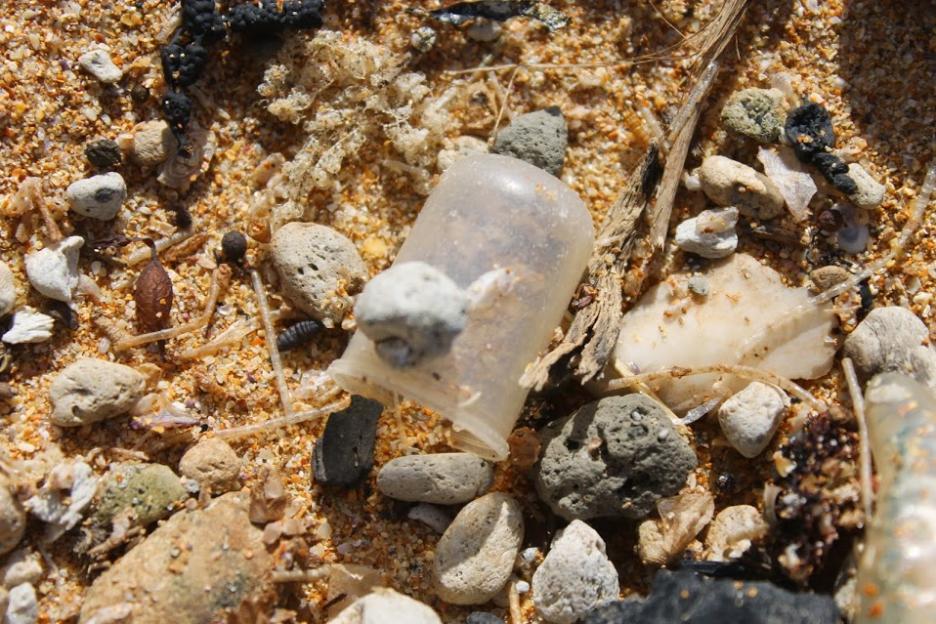September 21 - 27, 2014: Issue 181
Australia's Waters Are Full of Plastic, and We Put it There

CSIRO researcher Denise Hardesty inspects debris on North Stradbroke Island. - Picture courtesy CSIRO.
Australia's Waters Are Full of Plastic, and We Put it There
Did you know that 43 per cent of sea birds have plastic in their gut? Or that in some parts of our ocean there can be 40,000 pieces of marine debris per square kilometre? CSIRO have just finished the largest sample of marine debris data ever collected anywhere in the world and the results are very worrying for marine life. You may want to think twice about what you do with your rubbish on the beach this summer.
The world's largest collection of marine debris information has identified Australia's coastal rubbish is mainly plastic from Australian sources.
In a report released on September 15th, 2014, CSIRO scientist Denise Hardesty says her team surveyed sites approximately every 100 km along the Australian coastline.
"We found about three-quarters of the rubbish along the coast is plastic," she says. "Most is from Australian sources, not the high seas, with debris concentrated near cities."
She says the density of plastic in Australian waters ranges from a few thousand pieces of plastic per square kilometre to more than 40,000 pieces.
Marine debris includes items such as glass or plastic bottles, cans, bags, balloons, rubber, metal, fibreglass, cigarettes and other manufactured materials that end up in the ocean and along the coast. It can smother coral reefs, kill wildlife, and may pose a threat to human health.
"Approximately one third of marine turtles around the world have likely ingested debris, and this has increased since plastic production began in the 1950s," Dr Hardesty says. "We also estimate that between 5,000 and 15,000 turtles have been killed in the Gulf of Carpentaria after becoming ensnared by derelict fishing nets mostly originating from overseas."
She says the Tasman Sea south of Australia is a global hotspot for seabird impacts.
"We found that 43 per cent of seabirds have plastic in their gut. Globally, nearly half of all seabird species are likely to ingest debris, eating everything from balloons to glow sticks, industrial plastic pellets, rubber, foam and string."
"By garnering the information needed to identify sources and hotspots of debris, we can better develop effective solutions to tackle marine debris," says Dr Hardesty.
The research is part of TeachWild, a national three-year research and education program developed by Earthwatch Australia in partnership with CSIRO and Shell Australia's National Social Investment Program.
"This innovative national partnership has engaged with thousands of students and teachers, says David McInnes, Chief Executive Officer at Earthwatch. "It reaches more than one million Australians to help increase our understanding of the problems of marine debris."
Report and summary: http://www.csiro.au/marine-debris
Marine debris is what we call the waste that makes its way into our oceans, lakes and rivers. It is a major global threat to marine biodiversity.
By effectively ‘clogging up’ our oceans and water ways, marine debris has a direct impact on fish, amphibians, invertebrates, birds, reptiles, and mammals – including threatened and endangered marine species. And as the rate of rubbish in the ocean grows exponentially, this impact continues to increase.
In 2011 CSIRO partnered with Earthwatch to deliver the largest, most comprehensive marine debris research survey ever. The three year project is funded by Shell.
The marine debris research survey aims to identify and understand the threat marine debris poses to our wildlife and ecosystems by mapping out where – and how – it is accumulating along Australian coastlines.
CSIRO researchers have visited more than 170 sites around Australia, completing over 575 transects (or 'straight line surveys'), stopping at 100 kilometre intervals along the Australian coast, investigating:
• sources, distribution, and ultimate fate of marine debris
• the effectiveness of government policies and community action in reducing plastic pollution
• exposure of marine wildlife to debris
• the effects of ingestion and entanglement on marine wildlife populations.
The data collected are compiled in a national Marine Debris Database, designed to assist governments and industry in the formulation of waste management policies and practices intended to protect marine ecosystems.
This database is due to be published in mid 2014.
The project is part of TeachWild, a three-year marine debris research and education program, developed by EarthWatch Australia in partnership with CSIRO and Shell.
From Summary of Understanding the effects of marine debris on wildlife:
Prevention and Recommendations
The most effective way to reduce and mitigate the harmful effects of marine debris is to prevent it from entering the marine environment: cleaning up our oceans is a much less practical solution. To reduce litter inputs requires incorporating an improved understanding of debris at the local, regional and national levels.
Improved waste management efforts, targeted education and outreach activities, and technology solutions are also required.
We investigated drivers for releases of debris into the ocean and the potential effectiveness of responses in three contexts. Using our coastal survey data and interviews with more than 40 coastal councils around Australia we investigated the likely drivers for marine debris and effectiveness of local policy responses.
We found evidence for two main drivers, general consumer/user behaviour and illegal dumping of refuse.
Similarly, we found that local council outreach, which presumably affects user behaviour, and anti-dumping campaigns were both effective in reducing the debris found in coastal areas. We examined the drivers for lost fishing gear and found that they were a mix of overcrowding on fishing grounds, poor crew training, and enforcement evasion.
We also evaluated the effectiveness of incentive schemes, such as South Australia’s container deposit scheme, in reducing waste lost into the environment. The scheme appears to be very successful, reducing the number of beverage containers, the dominant plastic item in the environment, by a factor of three.
By garnering the information needed to identify sources and hotspots of debris, we can better develop effective solutions to tackle marine debris. For example, fisheries management aimed at reducing losses of fishing gear at sea would undoubtedly result in less wildlife harmed by entanglement and educating the next generation will improve our world for the future. Working together, scientists, industry partners, coastal managers and citizen scientists can make significant strides to reduce marine debris impacts in coastal areas and in the marine environment.
By garnering the information needed to identify sources and hotspots of debris, we can better develop effective solutions to tackle marine debris.
The most effective way to reduce and mitigate the harmful effects of marine debris is to prevent it from entering the marine environment in the first place. This requires incorporating understanding of debris into local, regional and national decision-making; improved waste management efforts; education and outreach activities; development of technology solutions; anti-dumping campaigns; reducing losses of fishing gear at sea; and incentives to reduce debris, such as South Australia’s container deposit scheme (which has reduced the number of beverage containers, the dominant plastic item in the environment, by a factor 3).
Working together, scientists, industry, coastal managers and citizen scientists can make significant strides to reduce marine debris impacts in coastal areas and in the marine environment.

A map showing the concentrations of plastic found in Australian waters. Courtesy CSIRO.

Plastic top washed up among pumice stone, ashes and bluebottles on a Pittwater Beach - an everyday sight. AJG Photo, 31.8.2014
A Subject- Related Study by UNSW published at beginning of September - 2014:
Tracking down the origins of ocean garbage patches
03 September 2014
UNSW mathematicians and oceanographers have developed a model that could reveal who is to blame for litter in the floating garbage patches in the world’s oceans. The best known area of concern is the Great Pacific Garbage Patch between Hawaii and California where pieces of plastic outweigh plankton in that part of the ocean, posing a risk to fish, turtles and birds. It is one of at least five garbage patches, each located in the centre of large ocean currents called gyres which suck in and trap floating debris.
Professor Gary Froyland and Robyn Stuart of the School of Mathematics, and Dr Erik Van Sebille of the Climate Change Research Centre, have created a model that can help determine where the litter came from – a difficult task for a system as complex and massive as the ocean. The research is published in the journal Chaos.
“In some cases, you can have a country far away from a garbage patch that’s unexpectedly contributing directly to the patch,” says Professor Froyland.
For example, the ocean debris from Madagascar and Mozambique would most likely flow into the south Atlantic, even though the two countries’ coastlines border the Indian Ocean.
The new model could also help determine how quickly garbage leaks from one patch into another, says Dr van Sebille: “We can use the new model to explore, for example, how quickly trash from Australia ends up in the north Pacific.”
At the heart of the researchers’ work on the origins and fate of floating rubbish lies a bigger question – how well do the ocean’s surface waters mix?
Fast-moving ocean currents form due to winds, differences in water temperatures, salinity gradients across the globe, and the forces caused by the spinning Earth.
Currents stir ocean waters, but they also serve as barriers that minimize mixing between different ocean regions, much like the blast of fast-moving air at the entrance of an air-conditioned store keeps the cold inside air from mixing with the warm outside air.
The researchers divided the entire ocean into seven regions whose waters mix very little. Their approach borrowed mathematical methods from a field known as ergodic theory, which has been used to partition interconnected systems like the internet, computer chips and human society, and the new analysis revealed the underlying structure of the ocean without getting bogged down in complex simulations.
“Instead of using a supercomputer to move zillions of water particles around on the ocean surface, we have built a compact network model that captures the essentials of how the different parts of the ocean are connected,” says Professor Froyland.
According to the new model, parts of the Pacific and Indian oceans are actually most closely coupled to the south Atlantic, while another sliver of the Indian Ocean really belongs in the south Pacific.
“The take-home message from our work is that we have redefined the borders of the ocean basins according to how the water moves,” says Dr van Sebille.
The geography of the new basins could yield insights into ocean ecology in addition to helping track ocean debris.
Also related:
NSW TO PUSH FOR NATIONAL BAN ON MICRO-PLASTIC POLLUTANTS
Minister for the Environment, Rob Stokes
August 28, 2014 - Thursday
Environment Minister Rob Stokes today called for a national ban on the sale and production of personal care products containing plastic micro-beads, which kill seabirds and are ingested by sea-life.
Mr Stokes announced that the NSW Government would convene an industry working group with the aim to phase out the pollutant by 2016.
“Micro-plastics measure less than 5mm, include non-biodegradable plastic found in many products such as shampoos, exfoliants and shower gels go down our sinks straight into the ocean.
“Once seabirds ingest micro-particles it can lead to blockages, choking and starvation.
“When micro-plastics enter the marine environment, due to their small size and ability to float, they are unlikely to ever fully degrade.
“Scientists around the world are worried about the health implications to humans who eat seafood contaminated by micro-plastics.
“Companies such as Unilever have already announced they will phase out the use of micro-plastics in their products across the globe by January 2015.”
Mr Stokes today launched a comprehensive assessment of published works on the science of Sydney Harbour by the Sydney Institute of Marine Science.
The report identifies that Sydney Harbour supports a diversity of organisms, which is rarely matched in other estuaries or coastal systems anywhere else in the world.
“The report draws on more than 300 scientific journal articles and reports and improves our understanding of how our actions affect these natural values.”
The NSW Office of Environment and Heritage (OEH) is just one of SIMS’s State Government partners and scientists from OEH contributed to the report.
The NSW Government has established the Marine Estate Management Authority to oversee reforms of the NSW marine estate. As part of the reforms, the Authority has established the Sydney Harbour Strategic Initiatives Network to drive the information sharing and collaboration that is needed to manage this unique waterway.
_____________________
The Sydney Institute of Marine Science (SIMS) has pleasure in presenting the inaugural Sydney Harbour Research Program Technical Report, Sydney Harbour: A Systemic Review of the Science. This report collates the currently available information within the world’s peer-reviewed, scientific literature, to provide a valuable guide to the current state of knowledge of the harbour. Please click on the image below to download the report.
New report Sydney Harbour: A systematic Review of the Science at: sims.org.au/wp-content/uploads/2014/08/SIMS-Harbour-Report_final_web-lowres1.pdf (2.73 MB)
See May 2014 Pittwater Online page: Vanity is Killing Our Oceans and All In Them - No More Microbeads